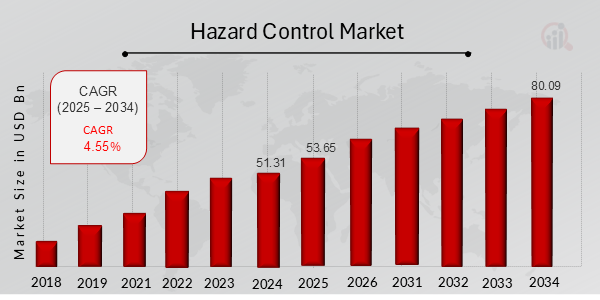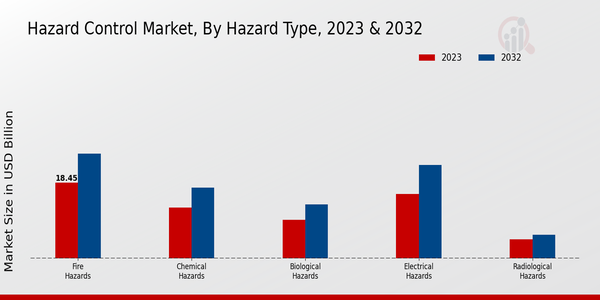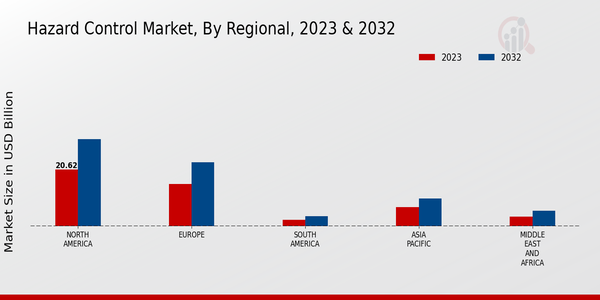Global Hazard Control Market Overview
As per MRFR analysis, the Hazard Control Market Size was estimated at 51.31 (USD Billion) in 2024. The Hazard Control Market Industry is expected to grow from 53.65 (USD Billion) in 2025 to 80.09 (USD Billion) till 2034, at a CAGR (growth rate) is expected to be around 4.55% during the forecast period (2025 - 2034)
Key Hazard Control Market Trends Highlighted
The Hazard Control market has been witnessing a surge in demand due to the increasing awareness of occupational safety, regulations, and technological advancements. The integration of automation and advanced sensor technologies facilitates real-time monitoring, early detection, and automated responses to hazards, leading to enhanced safety measures. Furthermore, the adoption of digitalization creates opportunities for data-driven decision-making, improving hazard management strategies and risk reduction. The market is expected to capitalize on advancements in wearable technology, AI-powered analytics, and mobile applications, offering personalized protection solutions and seamless connectivity. As organizations prioritize employee well-being and safety, the demand for hazard control solutions will continue to rise, presenting growth opportunities for market players.

Source: Primary Research, Secondary Research, MRFR Database and Analyst Review
Hazard Control Market Drivers
Increasing Demand for Safety and Compliance
Moreover, the interest of governments of many countries in workplace safety issues and the employment of stringent regulations on the matter stipulate hazard control solutions’ increased demand. Companies working in the manufacturing industry, as well as construction, mining, and healthcare, among others, require that their practices comply with the regulations adopted by these industries. This, in turn, leads to increased investment into the purchase of complex hazard control systems that guarantee the required results.
Advancements in Technology
Technological advancements have revolutionized the Hazard Control Market Industry, enabling the development of innovative and effective solutions. The integration of advanced technologies such as the Internet of Things (IoT), artificial intelligence (AI), and data analytics has enhanced the efficiency and accuracy of hazard identification, risk assessment, and control measures. These technologies have also led to the emergence of remote monitoring systems, predictive analytics, and wearable safety devices, which have further strengthened the market growth.
Rising Awareness of Occupational Hazards
The growing concern over people’s safety and health in the workplace will always push the market to expand. Since many people and companies have become more aware of the dangers that may result from numerous hazards, educational campaigns, government activities, and media reports have achieved greater awareness of risks concerning chemicals, exposure to loud sounds, and exposure to such potential harm from diverse ergonomic stressors. Therefore, there is always a surging interest in hazard control processes as businesses intend to provide employees with the best safety and health facilities.
Hazard Control Market Segment Insights
Hazard Control Market Hazard Type Insights
The Hazard Control Market is segmented into various hazard types, including electrical hazards, fire hazards, chemical hazards, biological hazards, and radiological hazards. Each hazard type presents unique challenges and requires specialized control measures. Electrical Hazards Electrical hazards pose a significant threat in various industries, including construction, manufacturing, and healthcare. The Global Hazard Control Market for electrical hazards is projected to reach USD 15.68 billion by 2026, growing at a CAGR of 4.8%. Key factors driving the growth include increasing industrial automation, rising demand for electrical safety equipment, and stringent government regulations.Fire Hazards Fire hazards are prevalent in numerous sectors, such as residential, commercial, and industrial. The Global Hazard Control Market for fire hazards is anticipated to reach USD 18.45 billion by 2027, exhibiting a CAGR of 5.2%. The growing adoption of fire suppression systems, fire-resistant materials, and fire safety training programs fuels market expansion. Chemical Hazards Chemical hazards arise from exposure to hazardous chemicals in various industries, including chemical manufacturing, transportation, and healthcare. The Global Hazard Control Market for chemical hazards is expected to reach USD 12.36 billion by 2025, growing at a CAGR of 4.9%.Stringent regulations regarding chemical handling and storage, along with increasing awareness about chemical safety, drive market growth. Biological Hazards Biological hazards encompass exposure to microorganisms, viruses, and other biological agents that can cause harm to human health. The Global Hazard Control Market for biological hazards is projected to reach USD 9.42 billion by 2028, growing at a CAGR of 5.6%. The rising prevalence of infectious diseases and the need for effective infection control measures contribute to market growth. Radiological Hazards Radiological hazards stem from exposure to ionizing radiation, primarily in industries such as nuclear power, healthcare, and research.The Global Hazard Control Market for radiological hazards is anticipated to reach USD 4.63 billion by 2024, growing at a CAGR of 4.3%. The increasing demand for radiation protection equipment and services, coupled with growing concerns about radiation exposure, drives market expansion. The segmentation of the Hazard Control Market into hazard types enables targeted and effective control strategies. By understanding the unique risks associated with each hazard type, industries can implement appropriate measures to minimize or eliminate hazards and ensure the safety of workers, the public, and the environment.

Source: Primary Research, Secondary Research, MRFR Database and Analyst Review
Hazard Control Market Control Method Insights
The Global Hazard Control Market is segmented by Control Method into Engineering Controls, Administrative Controls, and Personal Protective Equipment (PPE). Among these segments, Engineering Controls held the largest market share of 45% in 2023 and is expected to maintain its dominance throughout the forecast period. The growth of this segment can be attributed to the increasing adoption of advanced technologies such as automation and robotics in various industries to minimize workplace hazards. Administrative Controls, which involve establishing policies, procedures, and training programs to prevent accidents, accounted for a market share of 30% in 2023.Personal Protective Equipment (PPE), including items such as gloves, respirators, and safety glasses, held a market share of 25% in 2023. The increasing demand for PPE in industries such as construction, manufacturing, and healthcare is driving the growth of this segment.
Hazard Control Market Industry Insights
The Global Hazard Control Market segmentation by Industry highlights notable segments, including Manufacturing, Construction, Healthcare, Transportation, and Mining. These segments offer unique insights into the market dynamics and growth opportunities. The Manufacturing segment held a significant market share in 2023 and is projected to continue its dominance throughout the forecast period, owing to the increasing demand for hazard control solutions in industrial settings to ensure worker safety and compliance with regulations. The Construction segment is expected to witness a robust growth rate during the forecast period, driven by the growing construction activities worldwide, particularly in emerging economies.The Healthcare segment is gaining traction due to the rising awareness about infection control and patient safety, leading to increased adoption of hazard control measures in healthcare facilities. The Transportation segment is also expected to exhibit steady growth, driven by the need to enhance safety in the transportation of hazardous materials and the increasing adoption of advanced hazard control technologies. The Mining segment holds a significant market share and is expected to grow steadily, driven by the increasing mining activities and the need to mitigate hazards associated with mining operations.
Hazard Control Market Hazard Level Insights
The Hazard Level segment is a crucial aspect of the Global Hazard Control Market segmentation. Hazard Level refers to the severity and likelihood of hazards that exist in different industries and environments. The market is divided into three primary Hazard Level segments: High Hazard, Medium Hazard, and Low Hazard. High Hazard environments are characterized by the presence of severe hazards that pose a significant risk to life, health, and property. These environments often involve the handling of hazardous materials, extreme weather conditions, or high-energy processes.The High Hazard segment is expected to account for a notable share of the Global Hazard Control Market revenue due to the increasing emphasis on safety regulations and the need for advanced hazard control solutions in industries such as oil and gas, mining, and chemical manufacturing. Medium Hazard environments involve moderate risks and require appropriate hazard control measures to ensure safety. These environments may include manufacturing facilities, construction sites, and healthcare settings. The Medium Hazard segment is projected to experience steady growth as businesses prioritize risk mitigation and compliance with safety standards.Low Hazard environments pose minimal risks and require basic hazard control measures. These environments typically include offices, retail stores, and schools. The Low Hazard segment is anticipated to have the smallest market share but is still expected to grow as organizations seek to maintain a safe and healthy workplace. Understanding the Hazard Level segment dynamics is crucial for market participants to develop targeted solutions and strategies. By addressing the specific requirements of each Hazard Level, manufacturers and service providers can effectively cater to the diverse needs of industries and improve overall safety outcomes.
Hazard Control Market Regional Insights
The regional segmentation of the Global Hazard Control Market offers valuable insights into market dynamics across different regions. North America is anticipated to dominate the market, driven by stringent government regulations and increasing adoption of advanced hazard control technologies. Europe is another significant market characterized by a well-established chemical industry and the growing adoption of automation in hazard control systems. The APAC region is projected to witness substantial growth, fueled by rapid industrialization and increasing awareness about occupational safety.South America and MEA are emerging markets with potential for growth, as industries in these regions adopt best practices and invest in hazard control measures to enhance safety and mitigate risks.

Source: Primary Research, Secondary Research, MRFR Database and Analyst Review
Hazard Control Market Key Players And Competitive Insights:
The Hazard Control Market is highly competitive, and major players are continuously involved in research and development activities. These activities help in expanding the product portfolio of the firms and help them in attaining a competitive edge. Leading players in the Hazard Control Market are focusing on strategic initiatives such as mergers and acquisitions, strategic collaborations, etc. Market players are expanding their geographical presence in order to expand their customer base. Hazard Control Market players are putting relentless focus on research and development activities to cater to the needs of expanding end-use industries, which, in turn, will aid in enhancing their competitive position. The Hazard Control Market is marked by intense competition in nature that is characterized by the presence of both leading as well as emerging market players.Emerson is one of the leading companies in the Hazard Control Market that designs and delivers a wide of solutions, including control valves, pressure regulators, transmitters, etc. Being a leading company in the Hazard Control Market, Emerson boasts a strong brand image and wide presence across the globe. The distribution network of the company is also far developed, with activities spanning various end-use industries. R D focus of companies belonging to Emerson has led to the development of advanced products that cater to the diverse needs of expanding end-use industries and enhance their competitive position. ABB is another leading company operating in the Hazard Control Market, delivering comprehensive products, including PLC, DCS, motor drives, etc. The company is at the forefront of automation and digitalization, which is aiding it to attain a leading position in the Hazard Control Market. The company also has wide operations, with expertise in different end-use industries and delivers customized solutions.
Key Companies in the Hazard Control Market Include
- Chubb Limited
- Halma plc
- Eaton Corporation plc
- Emerson Electric Co
- Tyco International plc
- Siemens AG
- United Technologies Corporation
- Johnson Controls International plc
- 3M Company
- Rockwell Automation
- Honeywell International Inc.
- General Electric Company
- ABB Ltd
- Delta Electronics, Inc.
- Schneider Electric SE
Hazard Control Market Industry Developments
The global hazard control market size was valued at USD 51.31 billion in 2024 and is projected to grow at a CAGR of 4.55% during the forecast period 2023-2032. Increasing industrialization, growing awareness about workplace safety, and stringent government regulations drive market growth. The market is expected to witness significant growth in the coming years due to the rising adoption of automation and the increasing focus on safety in hazardous environments. Furthermore, advancements in technology, such as the development of wearable devices and sensors, are expected to contribute to market growth. Key industry participants include Honeywell International Inc., 3M, Johnson Controls International plc, Siemens AG, and Halma plc. Recent developments in the market include the launch of new products, such as portable gas detectors and intrinsically safe communication devices. Additionally, the market is witnessing strategic partnerships and acquisitions to strengthen market position and expand product offerings.
Hazard Control Market Segmentation Insights
Hazard Control Market Hazard Type Outlook
- Electrical Hazards
- Fire Hazards
- Chemical Hazards
- Biological Hazards
- Radiological Hazards
Hazard Control Market Control Method Outlook
- Engineering Controls
- Administrative Controls
- Personal Protective Equipment (PPE)
Hazard Control Market Industry Outlook
- Manufacturing
- Construction
- Healthcare
- Transportation
- Mining
Hazard Control Market Hazard Level Outlook
- High Hazard
- Medium Hazard
- Low Hazard
Hazard Control Market Regional Outlook
- North America
- Europe
- South America
- Asia Pacific
- Middle East and Africa
| Report Attribute/Metric |
Details |
|
Market Size 2024
|
51.31 (USD Billion)
|
|
Market Size 2025
|
53.65 (USD Billion)
|
|
Market Size 2034
|
80.09 (USD Billion)
|
|
Compound Annual Growth Rate (CAGR)
|
4.55% (2025 - 2034)
|
|
Report Coverage
|
Revenue Forecast, Competitive Landscape, Growth Factors, and Trends
|
|
Base Year
|
2024
|
|
Market Forecast Period
|
2025 - 2034
|
|
Historical Data
|
2019 - 2023
|
| Market Forecast Units |
USD Billion |
| Key Companies Profiled |
Chubb Limited, Halma plc, Eaton Corporation plc, Emerson Electric Co, Tyco International plc, Siemens AG, United Technologies Corporation, Johnson Controls International plc, 3M Company, Rockwell Automation, Honeywell International Inc., General Electric Company, ABB Ltd, Delta Electronics, Inc., Schneider Electric SE |
| Segments Covered |
Hazard Type, Control Method, Industry, Hazard Level, Regional |
| Key Market Opportunities |
Growth in the Healthcare Industry, Increasing Industrialization Advancements in Technology, Government Initiatives, Rising Safety Standards |
| Key Market Dynamics |
Rising demand for safety regulations Advanced technology integration Growing awareness of workplace safety Increasing industrialization Government initiatives |
| Countries Covered |
North America, Europe, APAC, South America, MEA |
Frequently Asked Questions (FAQ) :
The global Hazard Control Market is poised to reach USD 51.31 billion in 2024.
The market is expected to grow at a CAGR of 4.55% during the forecast period.
North America is expected to remain the largest regional market throughout the forecast period.
Rising concerns about workplace safety and increasing regulatory compliance are major growth drivers.
The industrial segment is projected to dominate the market, driven by the growing need for hazard control solutions in manufacturing facilities.
Key players include Honeywell, 3M, MSA Safety, DuPont, and Johnson Controls.
The market is projected to reach a valuation of USD 70.04 billion by 2032.
The Asia-Pacific region is expected to witness the highest growth over the forecast period.
Technological advancements, such as IoT and AI, are transforming the market landscape.
Economic uncertainties and fluctuating raw material prices pose challenges to market growth.

















